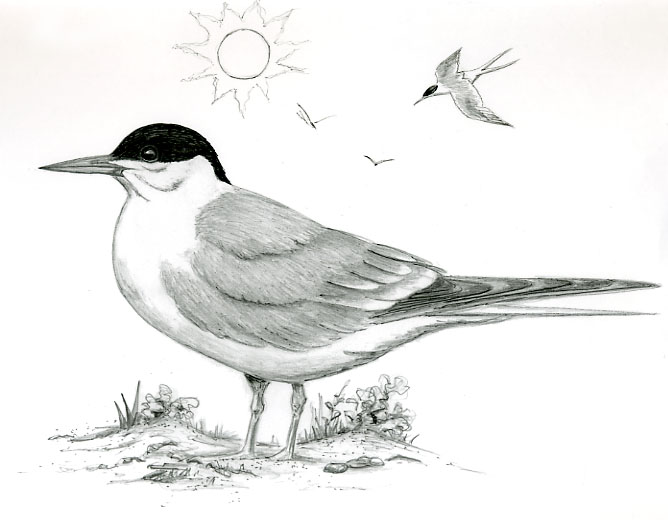
Dear Bird Folks,
Our 2008 daily trivia calendar has a question that I’m wondering if you know the answer to. Let’s see how smart you are. Here it is: What animal enjoys more hours of daylight than any other? Any guesses? By the way, none of us got it right.
– Matty, Brewster, MA
That’s easy, Matty,
Most of the time I stink at trivia, but this one is easy. The animal that enjoys the most hours of daylight is the rooster that lives in the yard behind me. That bird never shuts up and I doubt it ever sleeps. He starts crowing at the first hint of daylight and continues nonstop all day long. His owner knows I won’t complain because I’m the guy who is supposed to like all birds. But this rooster isn’t a bird, it’s an insomniac with feathers. I keep sending my neighbor recipes for chicken soup, but so far he has not taken the hint.
The real answer to your question is the Arctic Tern. You might think I know this answer because I’m super smart, and if you really believe that it’s fine with me. But the truth is I also have that same trivia calendar. That question appeared way back on April 28th. It is now the middle of September. That means you are either behind on your daily calendar readings or you just recently bought your calendar from the 90 percent off table at the store. Good for you. I love that table. That’s where I do most of my Christmas shopping.
As the name suggests, the Arctic Tern has much to do with the Arctic. While many Arctic Terns breed as far south as Cape Cod, a large number of them spend their summers well above the Arctic Circle, where the summer sun never sets. The twenty-four hours of sunlight gives these terns a great opportunity to find a mate, build a nest, raise a family and catch up on some reading. When I say, “build a nest,” I’m talking about a tern’s version of nest building. There are no trophy homes for these terns; they are strict minimalists. Most of their nests are nothing more than a shallow scrape in the sand. While sitting on the nest incubating adults will sometimes reach around and grab a bit of vegetation or other matter to add to the nest…but that seems to be more out of boredom than improving the nest itself.
If you have never taken the time to look at a photo of an Arctic Tern, do yourself a favor and Google one up on your computer or at least check out its image in your bird book. The Arctic Tern has a handsome light-gray body, a contrasting black cap on the head, blood-red bill and those beautiful long, slender tern wings and tail feathers. Arctic Terns are striking and elegant as they fly, but don’t let their delicate looks fool you. If you get near this bird’s nest, it will peck your face off. These four-ounce birds are ferocious when it comes to defending their families. Many a researcher has had to be patched up after having a run-in with the tern’s pointy beak. And on at least one occasion a flock of angry terns knocked a misguided Bald Eagle clear out of the sky and into the water, forcing the totally embarrassed national emblem to swim to shore and towel off.
Right now many of you, or at least a few of you, are thinking: Heck, lots of other birds nest in the Arctic region, why is this particular bird given credit for spending the most time in the sunlight? Well, kids, it’s what the Arctic Tern does after the breeding season that earns it the title of Sunlight King.
Within a few months after hatching in northern North America the young terns, along with the adults, head south. But instead of heading directly south, like normal migrating birds do, the adventurous Arctic Terns fly across the Atlantic to coastal Africa. Then for reasons known only to the terns and their travel agents, the Arctic Terns leave the warm water off Africa and head south to spend the bulk of their non-breeding season relaxing on the frigid ice flows near Antarctica. And I thought I had a bad travel agent.
When the terns arrive in Antarctica, guess what is waiting for them there (besides penguins and boatloads of penguin-seeking seasick tourists)? The well-traveled birds have arrived just in time for the Antarctic summer. This means they once again will be experiencing long days of summer sunshine, guaranteeing the Arctic Tern more hours of daylight than any other bird and more sun exposure than any creature on earth, except George Hamilton. Here’s one more piece of trivia for you, Matty. The Arctic Tern’s annual round-trip journey between the earth’s two Polar Regions covers an astonishing 22,000 miles. Each year this little tern, not much bigger than a grackle, travels more than any other bird in the world. The Sunlight King is the Migration King as well. However, there is one bird that I’d really like to see become king. That’s the big mouth rooster that lives behind me. I’d like to see him become Chicken a la King.